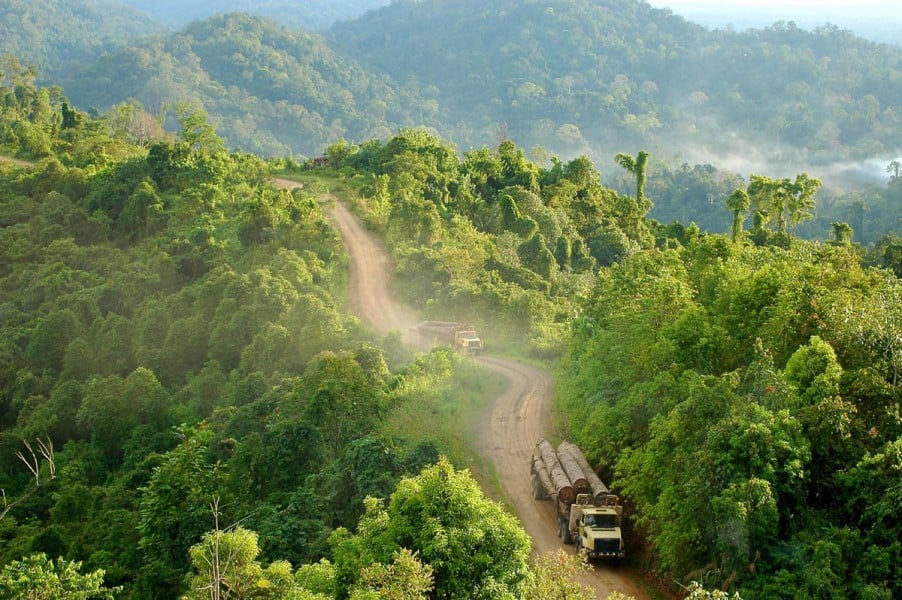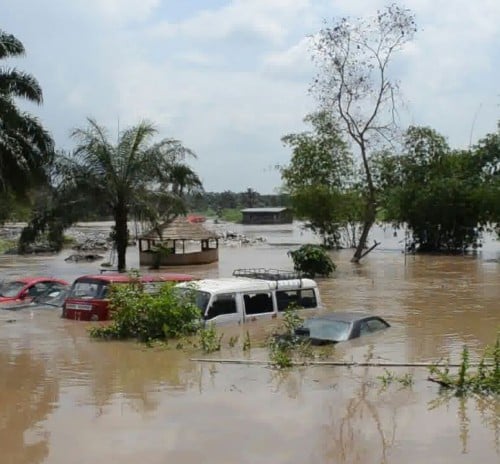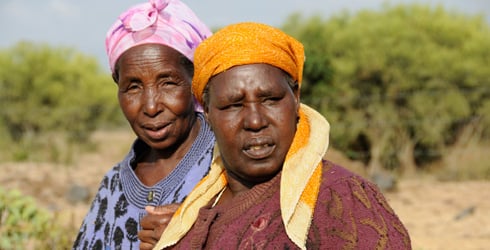The Democratic Republic of the Congo’s (DRC) plan to reduce emissions in the agriculture, forestry and other land use (AFOLU) sectors is robust, according to an analysis released November 12, 2015 by the Union of Concerned Scientists (UCS). By contrast, Brazil, India and Indonesia’s plans for limiting global warming emissions in similar sectors disappoint despite their status as important tropical forest nations.
Trends identified by UCS also see smaller countries doing more to analyze and reduce their land use emissions than more populated countries, the analysis showed.

Trucks carrying logs in Gunung Lumut, East Kalimantan, Indonesia. Photo by Jan van der Ploeg for Center for International Forestry Research (CIFOR).
The report, “INDCs, Take 3: The Land Sector in the Intended Nationally Determined Contributions of Brazil, Indonesia, India and the Democratic Republic of the Congo,” is the final white paper in a three-part series released by UCS. The report analyzed countries’ so-called Intended Nationally Determined Contributions (INDCs)—nation-specific action plans submitted to the United Nations outlining how they will reduce their global warming emissions in the 2020s—based on transparency, ambition, accounting standards and proposed actions. About 122 countries have submitted their INDCs, which are expected to shape negotiations at the upcoming climate conference in Paris.
“The land use sector, which accounts for about one-fourth of total global warming emissions, can’t be ignored if we want to solve the problem of climate change,” said Doug Boucher, director of the Tropical Forest and Climate Initiative at UCS and report author. “The climate mitigation potential of agriculture and forests is great, and needs to be fully realized to prevent the worst consequences of climate change that will occur if global temperatures rise by more than 2 degrees Celsius.”
Brazil, home to the world’s largest rainforest, has made history for achieving the largest emissions reductions of any country over the past decade. In its INDC, the country boasts a worthy goal to reduce its overall carbon emissions 37 percent by 2025 with or without international financing. However this ambition did not carry over to the country’s AFOLU sector emissions. Of greatest concern is that the nation pledges to eliminate only illegal deforestation in the Amazon, rather than reducing all forms of deforestation throughout the entire country.
“Brazil’s promises are inadequate if they claim they can address deforestation simply by going after illegal activities in the Amazon,” said Boucher. “The problem is bigger than illegality and bigger than the Amazon. Brazil also needs to reduce deforestation in other parts of the country.”
Indonesia’s INDC is also problematic on land use, the analysis revealed. Approximately 63 percent of Indonesia’s global warming emissions come from the AFOLU sectors, mostly due to deforestation for large-scale agriculture. The report points out that it is therefore surprising and worrisome that Indonesia’s INDC—which proposes a 29 percent emissions reduction by 2030 compared to business as usual, or 41 percent if it receives international financing—failed to present a goal for ending deforestation or peatland clearing.
“Indonesia currently has a moratorium on clearing primary forests and also banned peatland clearing in 2010,” said Boucher. “But the plan doesn’t say whether these commitments will continue let alone what sort of new initiatives will be implemented to achieve their overall emissions reduction goal.”
Unlike the other countries examined in the latest UCS report, India has already shifted away from net deforestation to a low rate of net reforestation, in other words the nation is growing back more trees than it is cutting down. In its 38-page INDC, India lists an overall goal of reducing global warming emissions 33-35 percent by 2030. Unfortunately, while their INDC is longer by far than other INDCs, it lacks the clarity necessary to effectively gauge India’s ambition, especially with regards to the AFOLU sectors.
“After review, much of the mystery surrounding land use in India’s INDC remains,” said Boucher. “They don’t specify to what degree their proposed emission reductions depend on international assistance and whether their proposed goals are annual or cumulative. And while they display ambition on reforestation the same cannot be said of their actions related to agriculture and natural forest degradation. In addition, even though they aren’t losing forestland overall because of reforestation, they fail to spell out what they’re doing to address deforestation.”
In terms of income, food insecurity, unemployment, and access to electricity and potable water, the DRC ranks as one of the least developed countries in the world. Yet of the four countries examined in this analysis, the DRC’s proposals for its land use sectors as laid out in its INDC were the most clearly defined. The DRC proposes a 17 percent carbon emissions reduction by 2030 compared to business as usual and breaks down how much of this will come from each sector and how the goal is contingent on international assistance. The country is home to the largest area of the Congo Basin rainforest, the world’s second-largest tropical forest.
“The DRC’s plan is clearer and includes more quantitative detail than plans submitted by far richer nations,” said Boucher. “Further, the DRC’s proposed reductions are in line with the amount of emissions they can cut and should cut, based on the extent to which their emissions have contributed to climate change.”
The four countries examined in this analysis—as well as China, the European Union, Mexico and the United States—make up 57 percent of all land use sector emissions, according to an earlier UCS study titled Halfway There, which is why they were the focus of this three-part white paper series.
“We analyzed climate pledges from countries that could make or break climate progress worldwide,” said Boucher. “It’s clear that to be climate leaders, these countries will need to make significant revisions on land use in their INDCs if we hope to effectively tackle emissions from this sector. Surprisingly, we found that developing countries like Morocco, Mexico and the DRC offer other nations a model for maximizing action on land use.”
Related posts
-

RDC : Les conséquences du changement climatique se font sentir plus rudement
-

Money row may sink climate talks
-

$248 USD million pledged to GEF climate fund for most vulnerable countries
